Rates for residential and business customers
- Residential customers
- Business customers
What is PG&E's minimum bill?
- It costs PG&E to manage its systems and provide electricity
- A minimum bill ensures all customers pay enough to cover these base costs.
- This includes customers who use little or no electricity.
How is the minimum bill calculated?
The charges for the minimum bill include components for:
- The generation of electricity or Energy Charge
- The delivery of energy or Minimum Delivery Charge
The Energy Charge is used to pay for:
- The electricity itself
The Minimum Delivery Charge is used to pay for:
- The transportation of the electricity over PG&E's grid
- Distribution maintenance
- Other charges approved by the California Public Utilities Commission to fund energy efficiency and low-income programs
The Minimum Delivery Charge accounts for the cost to deliver energy. It is:
- $10.12 for Non-CARE customers
- $5.06 for CARE customers
All customers are subject to pay both the Minimum Delivery Charge and Energy Charge associated with kilo-watt (kWh) usage.
Is my bill different if my energy is not supplied by PG&E?
PG&E's Energy Charge does not apply to Direct Access (DA) and Community Choice Aggregation (CCA) customers.
- The Energy Charge is based on the cost to procure energy provided by these providers, not PG&E.
- The costs incurred by the DA/CCA for procuring energy on their behalf can be found on the bill.
Note: All customers are responsible for the Minimum Delivery Charge.
How do these charges appear on my bill?
See sample energy statement below. These charges will appear on your bill if:
- PG&E procures your energy
- You are not enrolled in a Net Energy Metering (NEM) program like NEM2
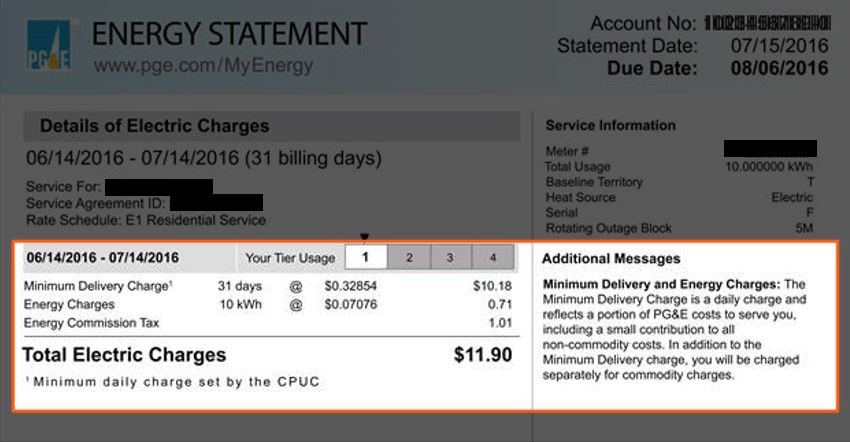
If you are a CCA customer you will also see the Minimum Delivery Charge. However, the Energy Charge will be found in the CCA section of your bill:
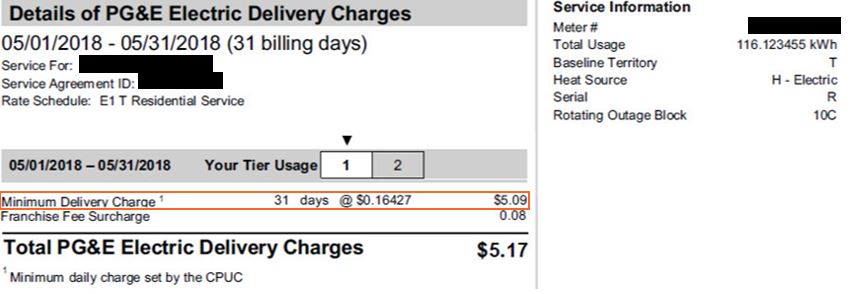
For NEM program customers, the Minimum Delivery Charge and Energy Charge are shown in two sections.
Still have questions about how NEM customers are billed? See the frequently asked questions below.
- Minimum Delivery Charge—billed monthly:

- Energy Charge (“Monthly NEM Charges”)—“banked” monthly:
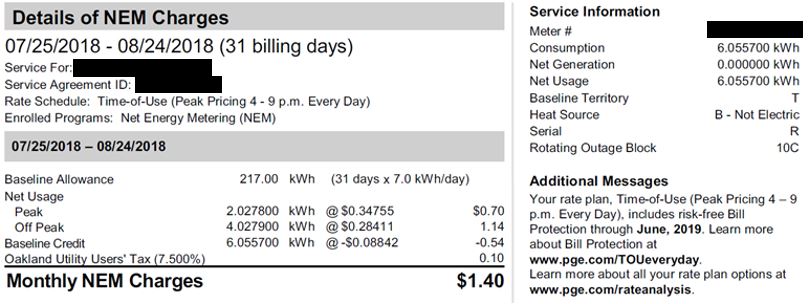
How does the minimum bill affect NEM customers?
- The first is the minimum bill charge of $10.12 for non-CARE customers and $5.06 for CARE customers.
- These monthly charges cover a portion of the fixed costs of serving electric customers.
- The second is your “Monthly NEM Charges”. These show:
- The sum of the net charges (on energy used from the grid)
- Credits accrued in that month. These credits are produced by exporting your solar power to the grid
Every 12 months you receive a "True Up" bill.
- This bill reconciles all of the NEM charges and/credits accrued monthly throughout the year.
The summary of year-to-date NEM Charges on your monthly bill (labeled “YTD Estimated NEM Charges at True Up”) shows:
- The year-to-date snapshot of all your energy charges
If you used more energy than you created over the course of the year, you'll owe a balance to PG&E.
If you owe a balance at the True Up, the total minimum bill charges paid over the course of the year will be credited back.
- This is because the minimum bill charges paid throughout the year also serve as prepayment of charges owed at True Up.
Example:
- Assume the sum of the NEM charges and credits after 12 months is $390.74.
- At the same time, the 12-month Minimum Delivery Charge is $118.96.
- The True-up amount is $390.74, but the amount owed (before taxes) is only $271.78.
- That's because the customer has already paid the $118.96 Minimum Delivery Charge over the 12 months.
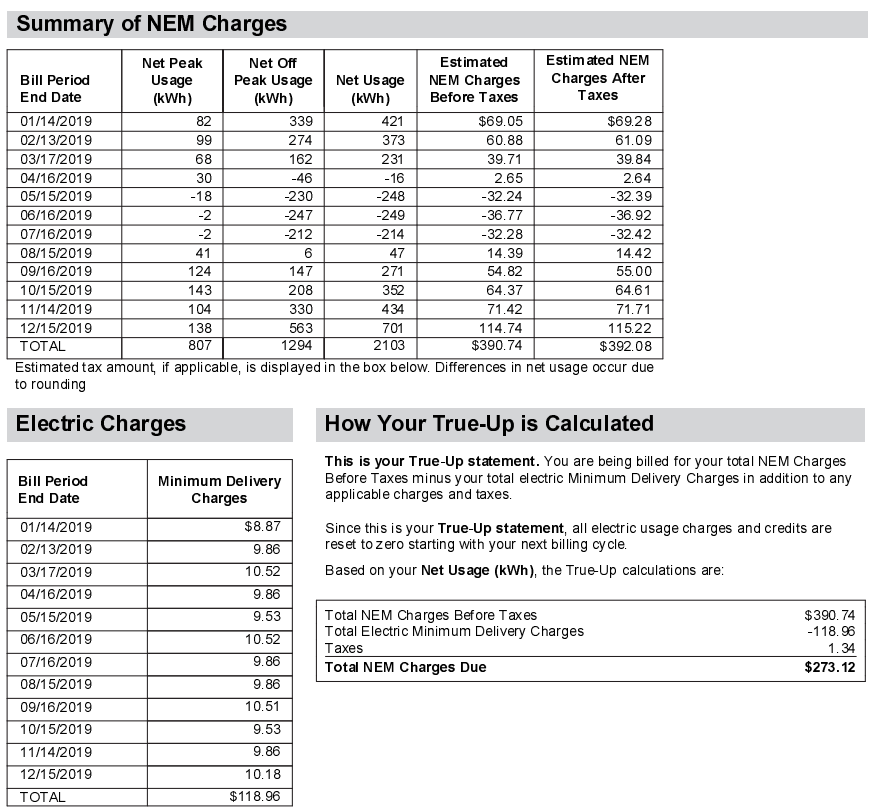
When will the Energy Charge be required on my NEM energy statement?
You will only be required to pay them at your True Up if the following is true:
- The total Energy Charge value is a positive amount
- The total NEM charges before taxes are less than your total Minimum Delivery Charges
Example:
- Assume the sum of the NEM charges and credits after 12 months is $100 (instead of $390.74).
- In this case, the customer is subject to the Minimum Delivery Charge of $118.96 at True-up.
- That's because the sum of the NEM charges and credits are lower than the Minimum Delivery Charge.
Still have questions?
- Call our solar customer service center at 1-877-743-4112 between 8 a.m. and 5 p.m., Monday through Friday.
- Find out more information about NEM billing by visiting NEM bill.
- For all other inquiries, call 1-800-743-5000 between 8 a.m. and 5 p.m., Monday through Friday.
PG&E combines approved changes to its electric rates only two or three times a year.
This is to limit the number of rate changes faced by our electric customers.
We change our natural gas supply rates every month, as required by the California Public Utilities Commission (CPUC).
The CPUC is a 5-member commission appointed by the Governor to better reflect competitive monthly gas market costs.
When PG&E needs to make any rate change:
1. We submit an application to the CPUC. The application describes:
- The upgrade required or a new program or service
- The annual or multi-year costs and impact on rates
2. Our application is reviewed in a public hearing and by stakeholders, including:
- Groups representing residential and business consumers
- Low-income and community advocates
- Environmental groups
- Agricultural interests
3. The CPUC issues a decision on the basis of what is "just and reasonable" for customers to pay in rates.
4. PG&E incorporates the approved changes into rates.
The General Rate Case
Every three years, PG&E files for the CPUC to review and authorize revenues collected for certain electric generation and distribution and natural gas distribution operations costs.
- That process is called the General Rate Case (GRC) for electric.
The Gas Transmission and Storage Rate Case
We file every four years for the recovery of natural gas transmission and storage operations under the Gas Transmission and Storage Rate Case (GT&S).
- In addition to the CPUC, the Federal Energy Regulatory Commission (FERC) approves the retail transmission portion of rates. These rates make up about 14 percent of PG&E's electric bundled rates.
- The remaining 86 percent is for rates and charges to recover those costs overseen by the CPUC.
PG&E's standard residential electric and natural gas rates are tiered.
- Tiered rates increase the price of energy as more energy is used during a billing cycle.
- Tiered rates are required by law in California, to encourage energy conservation.
- Customers who use less energy see lower bills as a result of the lower price in the lower tiers.
- Customers who use more energy are billed at the higher price in the higher usage tiers.
In addition to standard tiered rates, PG&E offers discounted rates for eligible customers enrolled in California Alternate Rates for Energy (CARE).
We also offer the Family Electric Rate Assistance (FERA) program to families who are not eligible for CARE.
Baseline Allowance
Most of PG&E's residential electric rate plans are tiered. They offer a monthly base amount of electric usage at the lowest price. This monthly base amount is called the Baseline Allowance.
The Baseline Allowance differs by geographic region and Climate Zone.
For residential tiered rates:
- Tier 1 includes the Baseline Allowance
- Tier 2 extends from 101% of baseline or greater
Learn more about Baseline Allowance
PG&E also offers electric Time-of Use-rates for residential customers.
- Some of these rates are tiered and others are not.
- Time-of-Use rates charge lower prices during off-peak energy periods.
- They allow customers to potentially reduce their bills by shifting some of their usage out of the higher-priced peak periods.
- Reducing electric usage during peak hours allows PG&E to reduce its cost to provide energy.
- Some Time-of-Use rates also have tiers.
Rates are the same across PG&E's entire service area. However, the amount of electricity allotted at the lowest available price (baseline) is different for each customer.
That difference depends on:
- Location
- Season (summer or winter)
- Household heating source
Baseline quantity is the minimum level of usage needed to satisfy most of an average customer's electricity needs in a specific climate zone.
Climate zones
To account for location and season, customers are broken into geographic regions called climate zones.
- PG&E has 10 different climate zones across our service area.
- These zones don't follow county or city boundaries. They are based on areas with similar geography and climate.
- Customers in hotter climate zones have higher baseline quantities than customers in cooler zones.
Learn why it changed
The California Public Utilities Commission (CPUC) voted to adopt a series of changes to the residential rate structure on July 3, 2015.
The new structure is more closely aligned with the actual costs of providing electric service.
The previous multi-tier rate structure was established during the energy crisis in 2001. At that time:
- Energy was in limited supply.
- Electricity prices were at record highs.
- Issues with electric reliability were frequent occurrences
- Renewable energy wasn’t widely accessible
- Meters were read manually.
Since then, things have changed. Progress has been made in nearly every sector of energy.
New energy structure
The new structure began to take effect in 2015. It is intended to:
- Be simpler.
- Be more closely aligned with the actual costs of providing electric service.
- Provide customers with a clearer understanding of how their energy use impacts their monthly bill.
The 2020 TOU reparing for the future
In 2020, residential electric customers were transitioned to a Time-of-Use (TOU) rate plan.
- TOU rate plans are where the price of electricity will depend on the time of day.
- With TOU rate plans, customers pay lower prices for electricity used during periods of low demand such as late night, early morning, and midday.
Get a custom rate analysis that makes a recommendation for you based on your past 12 months of energy usage data, please sign in to your account.
Ways to save energy and money
- Save energy and money through programs such as CARE and the Energy Savings Assistance Program.
- Find energy management tips and audit tools.
- Search energy efficiency programs and rebates.
- Discover payment options including Budget Billing.
Find rebates and ways to save
Get financial assistance information
Get payment plan information
Will PG&E make more money from these changes? No.
PG&E does not make any more money as a result of these changes.
- PG&E does not make more money when our customers use more gas or electricity.
- The amount of money PG&E makes is regulated by the California Public Utilities Commission.
PG&E makes money:
- On the cost of building the infrastructure to deliver energy
- By effciently running our business
- By effectively helping to lower our customers' energy use
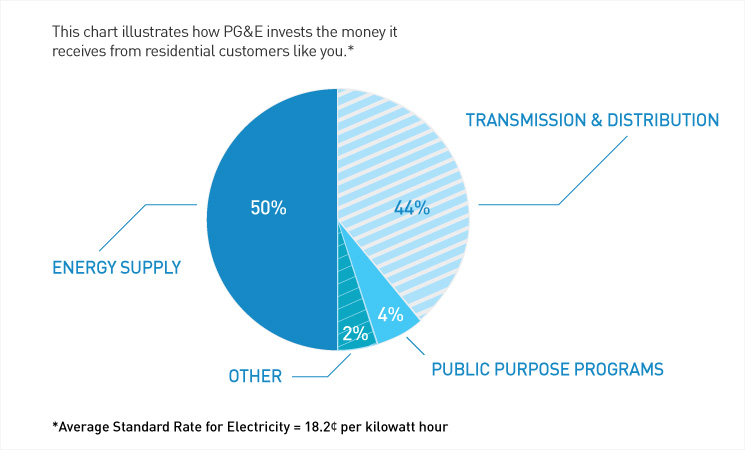
Energy Supply (50%): The cost of generating and purchasing power for PG&E customers.
- More than 50 percent of our electricity comes from sources that are free of greenhouse gas emissions.
- This gives us some of the cleanest energy supplies in the nation.
Transmission & Distribution (44%): Operating and maintaining the grid to deliver safe, reliable service.
- Includes new Smart Grid technology to reduce outages and restore service to customers faster.
Public Purpose Programs (4%): Promoting the public good. Includes:
- Discounts for income-qualified customers
- Investments in energy efficiency programs
- The California Solar Initiative
Other (2%):
- Legacy costs for nuclear plant decommissioning
- Electric generation deregulation
- The impact of the 2001-2002 California energy crisis
Baseline Allowance consists of an allotment of energy available at the lowest price. It's based on:
- Where you live
- Your heating source
- The season (summer or winter)
[TEXT MAY NEED UPDATING]
PG&E only makes changes to its electric rates two to three times a year.
- This helps limit the number of rate changes faced by our electric customers.
PG&E changes its natural gas rates every month, as required by the California Public Utilities Commission (CPUC).
- This is done to better reflect competitive monthly gas market costs.
How rate changes work
Whenever PG&E needs to change rates:
1. We make a proposal to the CPUC.
2. The proposal is then reviewed in a public hearing process along with many stakeholders, including:
- Consumer interests
- Business interests
- Low-income interests
- Environmental interests
- Agricultural interests
3. The CPUC makes a decision on what is "just and reasonable" for customers to pay in rates
4. PG&E reflects any change in rates as soon as possible.
PG&E files every three years for the CPUC to review revenues collected for its electric generation and distribution and natural gas distribution operations under its General Rate Case (GRC).
PG&E files every four years to review its revenues collected for natural gas transmission and storage operations under its Gas Transmission and Storage Rate Case (GT&S).
PG&E finished its 2014-2016 GRC in 2014. It currently presenting its 2017-2019 GRC and 2015-2017 GT&S rate case before the CPUC.
- Besides the CPUC, PG&E is regulated by the Federal Energy Regulatory Commission (FERC).
- FERC determines the utility's interstate transmission charges that make up about 10 percent of the revenues collected in electric rates.
- The remaining 90 percent are those revenues overseen by the CPUC.
The CPUC oversees state utility companies. It sets the amount of profit that each utility company can make.
Decoupling occus when this profit is no longer affected by the amount of gas or electricity sold.
Decoupling still allows PG&E some flexibility in revenues and rates based on actual sales. That's because sales can differ from forecasts due to:
- Unexpected weather
- Economic activity
- Conservation
Electric sales can be:
- Higher than forecasted during periods of unusually hot weather
- Lower than expected due to conservation efforts
In general, PG&E's profits do not depend on how much energy we sell. We have no reason to encourage customers to use more energy.
- PG&E gets incentives from the state by actually encouraging customers to use less energy.
Find ways to conserve energy. Find rebates for your business.
California leads the way in energy-efficiency programs.
- These programs date back to the 1970s and have been evolving ever since.
Over the past 30 years, per capita electricity use nearly doubled across the U.S. However, in California, the use has remained about the same for the past three decades.
- Energy-efficiency programs and policies help to maintain usage levels.
The CPUC oversees investor-owned utility (IOU) energy-efficiency programs.
- The agency establishes key policies and guidelines, sets program goals and approves spending levels.
[TEXT DOESN'T MATCH HEADER]
PG&E's electric and natural gas rates pay for a wide range of business operations.
Using energy more efficiently saves your business money on energy bills.
Conservation is also the fastest, most cost-effective way to reduce greenhouse gas emissions and fight global climate change.
Since 1976, PG&E and our customers have kept more than 160 million tons of carbon dioxide (CO2) out of the atmosphere, based on cumulative life-cycle savings.
Learn how we promote energy efficiency, provide clean energy solutions and fight climate change. Visit Corporate Sustainability and Responsibility.
Account used to maintain records of authorized costs and revenues.
Balancing accounts is like a PG&E profit-and-loss sheet. When energy sales and income are higher than expected, the balancing account is overcollected.
- Overcollected amounts are used as a credit when rates are set for the following year.
When energy sales and income are lower than expected, the balancing account is undercollected.
- Undercollected amounts are added to PG&E income levels for the next year.
A minimum amount of electricity or natural gas use that satisfies a substantial portion of the energy needs of the average PG&E customer.
The minimum amount is tied to a specific service area called a climate zone.
Baseline quantities:
- Are set by the California Public Utilities Commission
- Vary depending on:
- Customer location
- The time of year (summer or winter)
- Home heating source
A rate for a customer who receives energy supply and delivery services from PG&E.
- An unbundled or "direct access" rate is for those customers who receive energy delivery services from PG&E but take energy from another supplier.
A five-member state regulatory body that oversees the electric and natural gas operations of PG&E and other investor-owned utilities.
- Tasked with ensuring PG&E's customers have safe and reliable energy service at reasonable rates.
Ten zones across PG&E’s service area. Each represents similar geographic and climatic characteristics.
- These climate zones (P, Q, R, S, T, V, W, X, Y and Z) are used to create baseline amounts. The baseline amounts are used to calculate residential electric and natural gas bills.
- Climate zones are approved by the California Public Utilities Commission.
The amount of profit the California Public Utilities Commission allows us to make is separated from the amount of gas and electricity we sell through a process called decoupling.
- Even though decoupling separates our sales volumes from our profits, it still allows for some fluctuation in our revenues and rates based on actual sales.
- Sales can fluctuate from forecasts because of difficult-to-predict conditions such as:
- Weather
- Economic activity
- Conservation
Electric sales may be higher than forecast during a period of unusually hot weather. They might be lower than forecast because of conservation efforts.
Because of decoupoling, PG&E has no reason to encourage customers to use more energy. In general, our profits do not depend on how much energy we sell.
On the contrary, we actually receive state-approved incentives to encourage:
- Customer energy efficiency
- Conservation
- Use of renewable energy
A five-member regulatory agency that, among other things, oversees:
- U.S. wholesale energy trading markets
- National hydropower licensing
- Interstate natural gas pipeline and electric transmission construction
A regulatory process held every four years before the California Public Utilities Commission
- Sets the revenues PG&E can collect from its ratepayers to operate, maintain and expand its natural gas transmission pipelines and storage facilities.
A regulatory process held every three years before the California Public Utilities Commission.
- Sets the revenues PG&E can collect from its ratepayers to operate, maintain and expand its electric generation, electric distribution, and natural gas distribution operations.
A for-profit utility company such as PG&E owned by shareholders.
- Its operations and earnings are regulated by a state agency such as the California Public Utilities Commission.
A five-member federal agency charged with overseeing PG&E’s Diablo Canyon nuclear plant and other nuclear plants around the U.S.
- Ensures safe operation and on-site storage of nuclear waste
A utility which is collectively owned by the citizens of the area it serves. Includes:
- Rural cooperatives
- Municipal utilities
- Energy and power marketing authorities
A Rate Identification Number links to your specific electricity rate and any discounts for which you are enrolled. Use this tool to automate your use of electricity to times of day when costs are lowest.
How RINs work
- Scan the QR code on your PG&E bill with your camera app. The RIN tied to your current rate will be revealed. It provides real-time information about your electricity rate.
- Enter your RIN into your IoT device, electric vehicle or other smart device connected to the internet. Your device will determine the most cost-effective times to use electricity. That includes charging, running a pool pump, cooling your house and more.
- Follow your device’s on-screen instructions to optimize your energy consumption for maximum savings.
The benefits of RINs
Cost savings
When you sync your devices with your unique RIN, you take advantage of periods with lower rates. This can add up to significant and sustained cost savings over time.
Convenience
Say goodbye to manually adjusting devices to trim your electricity bill. RINs enable your devices to automatically optimize usage based on real-time rate information.
Grid stability
RINs help you proactively reduce use when the grid is operating at maximum capacity. You play a role in supporting the overall stability and efficiency of the electricity network.
Real-time accuracy
When you make changes to your rate, RINs accurately reflects those modifications. This precise approach guarantees you are always in control of your electricity expenses.
A rate structure for residential electric and natural gas customers of PG&E and other California investor-owned utilities.
- Increases the price for each unit of energy a customer uses
- Designed to encourage energy conservation
- Rates for each tier are set by the CPUC
More about rates
Compare rate plans
- Find the rate plan that fits your usage best.
- Get a rate analysis or browse all rate plans.
Save energy and money
Learn how to lower your energy use and your monthly bill.
Manage your account online
- Take care of tasks quickly and easily.
- Set up online alerts for bills and more.
